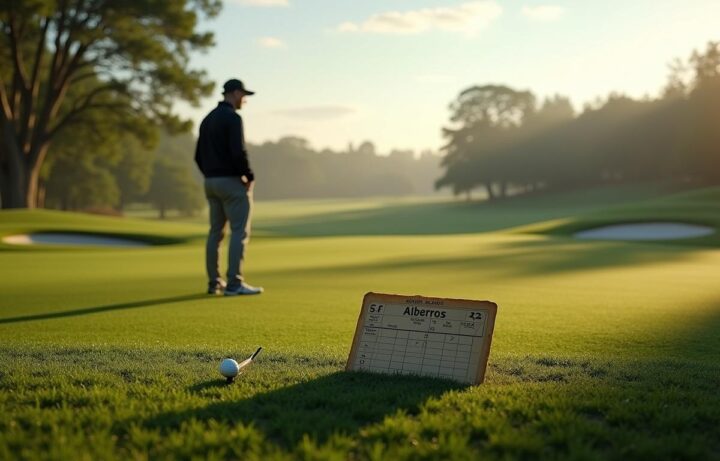What is an Albatross in Golf?
The albatross stands as an almost mythical achievement in golf but what is an albatross in golf?This remarkable scoring feat happens when a player completes a hole three strokes under par, which American golfers also call a “double eagle.” Amateur golfers face staggering odds of about 6 million to 1 to achieve this feat. These odds make it substantially rarer than a hole-in-one, which occurs at about 12,500 to 1.
This exceptional scoring term showcases the pinnacle of golfing achievement. Recreational players celebrate breaking 90 or scoring an occasional birdie. Yet the rarity becomes clear with only 981 tournament albatrosses recorded since 1870. The scoring marvel represents perfect execution, especially when you have par-5 holes where most albatrosses happen.
Players must execute an excellent drive and an extraordinary second shot to score -3 on a single hole. Gene Sarazen’s “Shot Heard ‘Round the World” in 1935 stands without doubt as the most celebrated example. His legendary albatross helped secure his Masters victory and etched this scoring term into golf’s history forever.

What is an Albatross in Golf?
Golf enthusiasts chasing rare achievements should learn about what is an albatross in golf. This remarkable feat stands as one of the sport’s most elusive treasures. Most golfers know about birdies and eagles, but an albatross showcases extraordinary skill and luck on the course.
Players score an albatross by completing a hole three strokes under par. This amazing achievement only happens on par-4 or par-5 holes. Golfers must hole out in just two strokes on a par-5 to record an albatross. A hole-in-one on a par-4 also counts as an albatross.
How It Compares to Birdie and Eagle
Golf uses bird-themed terms that showcase increasingly impressive achievements:
- Players score a birdie by completing a hole one stroke under par
- An eagle happens two strokes under par
- An albatross sits three strokes under par, making it much rarer than both
The nearly mythical condor (four under par) sits beyond the albatross. Only four players have recorded this feat in golf’s history. Players working to improve their what is an eagle in golf knowledge will better understand an albatross’s rarity with this progression.
Scorecards show an albatross as a simple “-3” for the hole. This modest notation hardly reflects the incredible difficulty of achieving this score. Even bogey golf seems routine by comparison.
In Golf What is an Albatross vs a Double Eagle
Regional differences explain the terminology of an albatross in golf. Both terms mean the same thing—scoring three under par on a single hole—but usage varies by location.
American golf circles first used “double eagle” in the 1910s. The term “albatross” became popular in the United Kingdom around 1929. Gene Sarazen’s famous shot at the 1935 Masters cemented “double eagle” in American golf vocabulary.
Golf purists often debate the term “double eagle” as mathematically incorrect. Their logic? An eagle means two under par, so a “double eagle” should equal four under par. Padraig Harrington summed it up: “There’s no such thing in life as a double eagle, is there? Two eagles side by side are two eagles, not a double eagle”.
What is an Albatross in Golf Terms
An albatross ranks among golf’s most celebrated achievements. Players face odds of approximately 6 million to 1. This makes it much rarer than a hole-in-one, which has odds of about 13,000 to 1.
Scoring an albatross demands perfect execution and a touch of luck. Players focused on lowering their golf handicap and scoring under 80 see the albatross as a pinnacle few will reach.
Records show 3,011 golfers have scored an albatross. PGA tournaments have seen 139 albatrosses since 1983. Each one combines distance, accuracy, and favorable bounces that make golf fascinating.
The albatross represents golf’s perfect storm. Power, precision, and providence line up to create a score so rare that even professional golfers might never experience one.
Understanding Golf Scoring Before the Albatross
Let’s talk about what an albatross means in golf. You need to understand how golf scoring works first. Every player from weekend warriors to tour pros uses the same scoring system. It’s a unique language of birds and strokes that sets up golf’s amazing achievements.
Par, Birdie, Eagle, and Bogey Explained
Par forms the foundation of golf scoring. The term comes from stock exchange lingo, where “par value” meant a stock’s standard value. In golf, par shows how many strokes a skilled golfer needs to finish a hole. This number assumes two putts on each green.
The term birdie started in 1899 when Ab Smith hit what he called a “bird of a shot” at Atlantic City Country Club. It means scoring one stroke under par. Eagles came next – they’re two strokes under par. After all, an eagle outranks a regular bird.
A bogey puts you one stroke over par. The name comes from “The Bogey Man” song back in the 1890s British golf scene. Double and triple bogeys add two and three strokes over par.
Scoreboard numbers tell the story:
- Par = 0 (the baseline)
- Birdie = -1
- Eagle = -2
- Bogey = +1
What is an Eagle in Golf and How It Guides Us to Albatross
Eagles give us vital context to appreciate how special an albatross is. An eagle means you beat par by two strokes. On a par-5, you’ve finished the hole in three shots instead of five.
Players score eagles most often on par-5 holes. Big hitters can reach these greens in two shots. Martin Laird topped the PGA Tour in 2019 with eagles on 1.18% of holes played. Average golfers with 16-20 handicaps rarely see eagles. They’re lucky to get one in a year.
The jump from eagle to albatross makes sense on paper – an eagle is two under par, an albatross is three under. The challenge gets much harder between these two scores.
How Scoring under 80 Relates to Rare Feats
Breaking 80 is a big deal in golf. Only about 5% of recreational players can do it regularly. You need to shoot 79 or better on a standard par-72 course. This means staying within 7 strokes over par through all 18 holes.
The odds of breaking 80 in golf are low, players often have single-digit handicaps. This puts them in a special group of skilled golfers. Their skill level matters when we talk about albatrosses because breaking 80 builds the foundation for these rare achievements.
The connection makes sense when you look at what each feat needs. Breaking 80 needs rock-solid consistency with little room for mistakes. An albatross needs perfect execution on one hole. Both show different kinds of golf mastery.
An albatross stands at the peak of scoring efficiency in golf. You need massive distance to reach par-5 greens in two shots and pinpoint accuracy to hole out from far away. Players who break 80 have the basic skills for these rare scoring chances. Yet many pros go their whole careers without seeing an albatross.

Why Albatross is So Rare
Scoring an albatross in golf is like winning the lottery – the math makes it almost impossible. Most experienced golfers might never see this amazing feat in their lifetime.
Odds of Scoring an Albatross vs Hole-in-one
The statistics behind an albatross are mind-boggling. Amateur golfers face odds between 1 million and 6 million to 1. This is a big deal as it means that getting an albatross is much rarer than a hole-in-one, which sits at about 12,500 to 1 for amateurs.
Pro golfers have better chances, but the odds still aren’t great. Their shot at an albatross is around 1 million to 1, while hole-in-one odds improve to about 2,500 to 1. Each year, only 200 golfers record an albatross, while roughly 40,000 players sink a hole-in-one.
Getting struck by lightning (555,000 to 1) has better odds than scoring an albatross. These numbers make sense given the incredible precision needed.
What is an Albatross in Golf Scoring
A golfer’s scorecard shows an albatross as a simple “-3” for the hole. This tiny mark doesn’t do justice to this incredible achievement. Records show only 3,011 golfers have ever scored an albatross. The PGA has seen just 139 albatrosses since 1983.
Robby Shelton’s albatross in March 2024 proves that even with perfect conditions and amazing skill, this feat remains incredibly rare.
Factors that Make It nearly Impossible
Several perfect elements must line up to score an albatross. Less than 10% of golfers have the skill and power to even try for one. Without reaching a par-5 in two shots, an albatross is impossible.
A golfer needs:
- Exceptional distance off the tee
- Pinpoint accuracy on the approach shot
- Favorable course conditions and hole design
- Lucky bounces and rolls
Dean Knuth, USGA’s former senior director of handicap, puts it simply: “Someone has to hit two great shots. You have to have length and ability”. This achievement surpasses elite play for golfers working on their handicap or trying to score under 80.
These factors explain why an albatross makes a hole-in-one look common, and why bogey golf remains a realistic goal for most weekend players.
Famous Albatross Moments in Golf History
Golf’s storied history features a handful of extraordinary albatross shots that showcase both skill and luck. These rare three-under-par achievements have created some of golf’s most unforgettable moments.
Gene Sarazen’s 1935 Masters Shot
Gene Sarazen’s legendary shot at the 1935 Masters stands out as the most famous albatross in golf. He trailed leader Craig Wood by three strokes when he arrived at Augusta National’s par-5 15th hole. Sarazen needed something special. He used his self-designed 4-wood “Turf Rider” from 235 yards out and struck what became “the shot heard round the world”. The ball found the cup for an albatross that instantly erased Wood’s lead. He ended up tying and defeating Wood in a 36-hole playoff, which completed his career Grand Slam. This shot remains the standard that measures all other eagle achievements in golf, even ninety years later.
Louis Oosthuizen at the 2012 Masters
Louis Oosthuizen made golf history in 2012 by scoring the first albatross on Augusta’s par-5 second hole. The South African golfer’s perfect 4-iron shot from 253 yards rolled across the green’s entire width before dropping into the hole. This spectacular achievement launched Oosthuizen from two strokes behind leader Peter Hanson to one stroke ahead. Albatross shots become even more special at prestigious tournaments like the Masters. Though Bubba Watson defeated him in a playoff, Oosthuizen’s shot joined elite company as just the fourth albatross in Masters history.
Brendan Steele’s LIV Golf Albatross
Brendan Steele achieved the latest notable albatross in August 2024 – the first in LIV Golf history. The mammoth 615-yard par-5 17th hole at Greenbrier saw Steele’s second shot from 287 yards land just short of the green and roll into the cup. “I couldn’t see it go in, but you always know by the crowd whether it’s just a good shot or whether it’s gone in,” Steele said afterward. This remarkable shot boosted his score from 3-under to 6-under. Such moments inspire golfers working to lower their handicap or score under 80, showing golf’s extraordinary possibilities.

How to Improve Your Chances of Scoring One
Scoring an albatross in golf might seem like chasing a unicorn, but proper preparation can boost your slim chances of joining this exclusive club. Statistics show that less than 10% of all golfers know how to attempt this feat. Let me show you how to become one of those select few.
Mastering Long Drives and Second Shots
Your trip to scoring an albatross starts with power and precision. Your driver and long irons must be in top condition. You need to develop consistent distance control with your fairway woods because these clubs often deliver the vital second shots on par-5s. An albatross demands a perfect combination of a powerful drive and an extraordinary approach. Regular practice with these clubs should focus on shots between 150-250 yards – typical albatross-making distances.
Choosing the Right Par-5 holes
Not every par-5 gives you the same shot at an albatross. Look for shorter par-5s with favorable layouts, preferably under 500 yards with minimal hazards. Downhill holes or those with firm fairways can give extra roll and help average players get the distance they need. Scoring an albatross becomes slightly easier on courses that reward aggressive play through their design.
Weather and Course Layout Considerations
Weather plays a huge role in your chances of scoring an albatross. Dry, firm conditions help the ball roll further, which means you might reach greens in two shots. Playing with tailwinds can add vital yards to your drives. Bad weather ruins your chances – rain and soggy courses cut your distance and make accuracy harder. Course knowledge gives you an edge – you’ll spot opportunities in slopes and contours that casual players miss.
Golf Handicap and Skill Level Required
The hard truth about scoring an albatross? You need exceptional skill. Players who can improve their golf handicap or score under 80 make up the small group that might actually pull this off. Hole-in-one scorers have an average handicap of 14, which proves that even modest skills can create miracles with enough luck. The bar sits much higher for albatrosses. Professional tournaments see just a handful of albatrosses each year, even with the world’s best golfers using perfect equipment and refined techniques.
What is an Albatross in Golf Frequently Asked Question
What exactly is an Albatross in Golf?
An albatross in golf occurs when a player completes a hole three strokes under par. This extraordinary feat is typically achieved by holing out in two shots on a par-5 hole or scoring a hole-in-one on a par-4.
How Rare is an Albatross Compared to other Golf Achievements?
An albatross is exceptionally rare, with odds of approximately 6 million to 1 for amateur golfers. This makes it significantly rarer than a hole-in-one, which has odds of about 12,500 to 1.
What’s the Difference between an Albatross and a Double Eagle?
There is no difference. “Albatross” and “double eagle” are interchangeable terms used to describe scoring three under par on a single hole. The term “albatross” is more commonly used outside the United States.
Has any Golfer ever Achieved Something better than an Albatross?
Yes, although extremely rare, there is a feat even more impressive than an albatross. It’s called a “condor,” which is four under par on a single hole. Only a handful of condors have ever been recorded in golf history.
How can a Golfer Improve their Chances of Scoring an Albatross?
To increase the slim chances of scoring an albatross, golfers should focus on mastering long drives and accurate second shots, choose suitable par-5 holes, consider favorable weather and course conditions, and continuously work on improving their overall skill level and golf handicap.
What Courses are Known for Albatross Opportunities?
Some golf courses are more conducive to albatrosses due to their layout and reachable par-5 holes. Notable examples include Augusta National’s 15th hole and the 18th at St. Andrews, where history has seen a few rare albatrosses.
Who are Some Famous Golfers Who Have Scored an Albatross?
Golf legends such as Gene Sarazen, Louis Oosthuizen, and Phil Mickelson have recorded albatrosses during professional tournaments, etching their names into golf history with these remarkable achievements.
Can an Albatross Occur on a Par-3 Hole?
No, an albatross cannot occur on a par-3 hole. The best possible score on a par-3 is a hole-in-one, which is only two strokes under par. An albatross requires scoring three under par on a single hole, making it possible only on par-4s or par-5s.
How is an Albatross Recorded on a Scorecard?
An albatross is recorded on the scorecard as a score that is three strokes below the hole’s par. For example, if a player makes a 2 on a par-5, it’s marked as a 2, with a notation or highlight to indicate the rare accomplishment.
How Does Scoring an Albatross Affect a Golfer’s Confidence or Reputation?
Scoring an albatross can significantly boost a golfer’s confidence and is often seen as a once-in-a-lifetime achievement. It can enhance a player’s reputation, especially in competitive settings, showcasing exceptional skill and precision.


